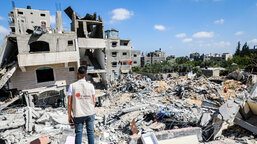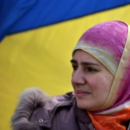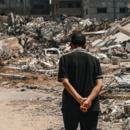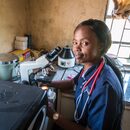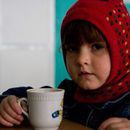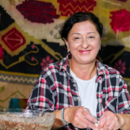Gaza, a strip of isolated land smaller than Prague, is home to 2.3 million people. It is one of the most densely populated areas on the planet - and in a confined space. The Gaza Strip has been described as an "open-air prison", its inhabitants have long been deprived of basic needs, which are constantly growing. What is life like in Gaza, what do its inhabitants face and how has the recent escalation of the conflict worsened the situation?
A long-term humanitarian disaster
The Gaza Strip has been described as an "open-air prison". The densely populated enclave is 41 kilometres long and 10 kilometres wide, bordered by the Mediterranean Sea, Israel and Egypt. The whole of Gaza is surrounded by barbed wire and a wall that is forbidden to approach within 100 metres. Israel controls the border crossings and allows Palestinians to leave Gaza only in "extremely rare cases", such as overnight labour or when their lives are in danger. Meanwhile, the movement restrictions do not apply to Israelis, Jewish settlers and foreigners, who are free to travel in and out of the Gaza Strip.
The needs of the local population have long been unmet and are growing. Schools are overcrowded and basic infrastructure such as electricity, water, sanitation and social services have been inadequate for many years. Electricity is only available for a few hours a day and many people do not have sufficient access to clean water.
More than 60 per cent of Gaza's population is living below the poverty line. The unemployment rate is one of the highest in the world, reaching up to 45 per cent.
Moreover, half of Gaza's population is made up of children and adolescents, with up to 40 per cent under the age of 14. They have little or no prospect of a better future or access beyond the Gaza Strip.
The escalation of the conflict on 7 October has dramatically worsened the already intolerable living conditions for the people of Gaza. Since the escalation began, more than 5,000 people have lost their lives in Gaza, including more than 2,000 children. More than 14,000 have been injured. When Israel called on Gazans to evacuate the northern part of the Strip in response to the Hamas attack, people had nowhere to go and nowhere to hide. According to the UN, Israeli air strikes have damaged or destroyed 40% of the homes in Gaza and much of the area has become rubble.
The people of Gaza have no access to electricity, water, fuel, food or medicine, which has greatly exacerbated the humanitarian crisis in the area. "Tensions continue to rise and more and more innocent people are paying the ultimate price, as the dramatic number of deaths and destruction in Gaza shows," the Patriarchs and Heads of Churches in Jerusalem said in a statement.
Who controls Gaza?
In 2007, the radical Hamas movement took control of the Gaza Strip and ousted the Palestinian Authority, which still governs the second Palestinian region in the West Bank. Since the same year, the Gaza Strip has been under a long-term land, air and sea blockade by Israel. This is despite calls from the UN and human rights organisations, which have warned of the devastating impact of the blockade on civilian lives. According to the UN and other organisations, the Gaza Strip is still under military occupation by Israel.
Between 2008 and 2023, prior to the current conflict, air strikes killed 6407 Palestinians in the occupied territories, including 5360 in Gaza, according to the UN. During the same period, 308 Israelis were killed.
In response to the tragic attack by Hamas on 7 October, which killed 1400 Israelis, Israel launched retaliatory bombing of the Gaza Strip. The continued bombardment has caused a humanitarian catastrophe in Gaza, trapping over two million Palestinians in a territory from which there is nowhere to escape.
The disruption of humanitarian aid deepens the crisis in the Gaza Strip
As the conflict escalates, humanitarian aid supplies to Gaza have been cut off, including drinking water and electricity. Hospitals can only operate for a few hours a day and depend on power from generators.
The vast majority of Gazans were already dependent on humanitarian aid before the conflict escalated. Israel controls the fishing industry, and the long-standing blockade and dense population make it impossible for Gazans to grow enough food.
Thus, the humanitarian situation in Gaza was already desperate before the conflict escalated. Moreover, Israel is refusing to allow humanitarian aid into the area until Hamas releases the Israeli hostages it has held in Gaza since the attack of 7 October. After 13 days, it has been possible to negotiate limited humanitarian aid deliveries through the Egyptian Rafah crossing. It was through this route that the first 20 trucks of humanitarian aid entered Gaza. However, this aid is not enough. More than 1.6 million people in the Gaza Strip are in urgent need of humanitarian aid. The current aid is only four per cent of the aid that went into Gaza before the conflict escalated. According to the UN, it is essential to increase humanitarian aid to at least 100 trucks per day.
Because of the lack of access to clean water, cases of chicken pox, scabies and diarrhoea are on the rise in the Gaza Strip. Unless the situation improves, the incidence of these diseases will continue to rise due to the disastrous sanitary conditions.
There are 1.4 million people in the Gaza Strip who have had to leave their homes. More than half a million are staying in emergency shelters. There are no civilian air-raid shelters in Gaza, so most residents seek safety in hospitals, churches or schools. Unfortunately, even these are not spared from attacks.
Our colleague from Caritas Jerusalem, twenty-six-year-old Viola, and her young daughter and husband lost their lives in an airstrike on a building adjacent to the Greek Orthodox Church of St Porphyrios, which served as a shelter for 500 people. Among the victims were Viola's sister and her two children. Several other people were reportedly trapped under the rubble. According to the Greek Orthodox Patriarchate, the building associated with the church, which is one of the oldest in Gaza, collapsed in an explosion caused by Israeli rocket strikes.
St Porphyrios Church served not only as a place of worship, but also as a relief centre that provided food, clothing, and medical care to the displaced and other vulnerable groups.
Caritas’ help in Gaza
Our sister organisation, Caritas Jerusalem, has long been helping in the Gaza Strip. It focuses mainly on providing health services, whether it is providing primary care, outreach health services, treating the injured or promoting proper nutrition to children suffering from anaemia, a common health problem in Gaza. Caritas Jerusalem also provided psychosocial care, especially for children living in armed conflict.
However, due to the extensive and ongoing bombing, Caritas Jerusalem had to temporarily suspend its assistance for security reasons. However, its staff still remain in the Gaza Strip. As soon as the security situation permits, Caritas Jerusalem staff are preparing to resume their medical services and provide assistance to the wounded and long-term sick residents.
In the past, Caritas Czech Republic has also assisted in the Gaza Strip, especially Palestinian youth with access to the labour market. We have also supported Palestinian women to set up their own businesses so that they can provide for their families.




